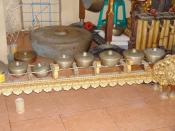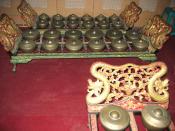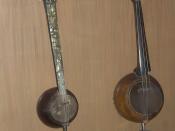GONG
Gong Wadon (wah-doan) - Bali. The largest Balinese gong, measuring slightly under a meter. The wadon is "loose", meaning the face is relatively thin and vibrates freely. The wadon trades with the lanang in ending the metric cycle.
Gong Lanang (lah-nahng) - Bali. A mate to the wadon (lanang means male and wadon means female), it is slightly smaller and about a step higher in pitch. The lanang is a "tight" gong, the face being thicker than the wadon. The lanang trades with the wadon in ending the metric cycle.
Gong Racks
Bonang (boh-nahng) or Bonang Barung - Java/Bali. A double horizontal row (usually) of from 10 to 14 gongs with rounded nipples, tuned to a scale and played by one person with a pair of cord wrapped sticks. There is usually one bonang per scale.
Trompong (trohm-pong) - Bali. A horizontal row of usually 12 Balinese gongs with conical nipples, tuned to a scale and played by one person only with cord wrapped sticks.
The trompong has a lower pitch range than reong.
Reong (ray-ong) - Bali. A horizontal row of small gongs with conical nipples, tuned to a scale and played with cord wrapped sticks by one or more players. Two reong pots can also be mounted vertically on either end of a stick. The reyong is one of the more difficult instruments to master, as it requires a high degree of precision and coordination with the other players. However, the reyong is capable of creating some of the more spectacular effects of the ensemble and is a key instrument.
Kempli (kehm-plee) - Bali. A small gong laid over a lace of cord strung within a box which functions as a stand. Kempli is usually played with a...


